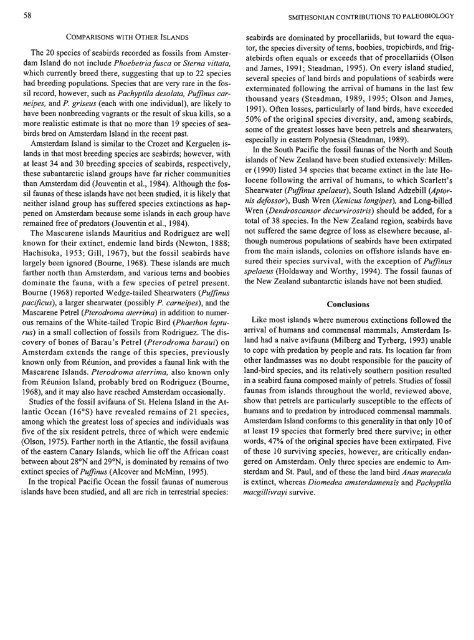PDF (Lo-Res) - Smithsonian Institution Libraries
PDF (Lo-Res) - Smithsonian Institution Libraries
PDF (Lo-Res) - Smithsonian Institution Libraries
You also want an ePaper? Increase the reach of your titles
YUMPU automatically turns print PDFs into web optimized ePapers that Google loves.
58 SMITHSONIAN CONTRIBUTIONS TO PALEOBIOLOGY<br />
COMPARISONS WITH OTHER ISLANDS<br />
The 20 species of seabirds recorded as fossils from Amsterdam<br />
Island do not include Phoebetria fusca or Sterna vittata,<br />
which currently breed there, suggesting that up to 22 species<br />
had breeding populations. Species that are very rare in the fossil<br />
record, however, such as Pachyptila desolata, Puffinus carneipes,<br />
and P. griseus (each with one individual), are likely to<br />
have been nonbreeding vagrants or the result of skua kills, so a<br />
more realistic estimate is that no more than 19 species of seabirds<br />
bred on Amsterdam Island in the recent past.<br />
Amsterdam Island is similar to the Crozet and Kerguelen islands<br />
in that most breeding species are seabirds; however, with<br />
at least 34 and 30 breeding species of seabirds, respectively,<br />
these subantarctic island groups have far richer communities<br />
than Amsterdam did (Jouventin et al., 1984). Although the fossil<br />
faunas of these islands have not been studied, it is likely that<br />
neither island group has suffered species extinctions as happened<br />
on Amsterdam because some islands in each group have<br />
remained free of predators (Jouventin et al., 1984).<br />
The Mascarene islands Mauritius and Rodriguez are well<br />
known for their extinct, endemic land birds (Newton, 1888;<br />
Hachisuka, 1953; Gill, 1967), but the fossil seabirds have<br />
largely been ignored (Bourne, 1968). These islands are much<br />
farther north than Amsterdam, and various tems and boobies<br />
dominate the fauna, with a few species of petrel present.<br />
Bourne (1968) reported Wedge-tailed Shearwaters {Puffinus<br />
pacificus), a larger shearwater (possibly P. carneipes), and the<br />
Mascarene Petrel {Pterodroma aterrima) in addition to numerous<br />
remains of the White-tailed Tropic Bird {Phaethon lepturus)<br />
in a small collection of fossils from Rodriguez. The discovery<br />
of bones of Barau's Petrel {Pterodroma baraui) on<br />
Amsterdam extends the range of this species, previously<br />
known only from Reunion, and provides a faunal link with the<br />
Mascarene Islands. Pterodroma aterrima, also known only<br />
from Reunion Island, probably bred on Rodriguez (Bourne,<br />
1968), and it may also have reached Amsterdam occasionally.<br />
Studies of the fossil avifauna of St. Helena Island in the Atlantic<br />
Ocean (16°S) have revealed remains of 21 species,<br />
among which the greatest loss of species and individuals was<br />
five of the six resident petrels, three of which were endemic<br />
(Olson, 1975). Farther north in the Atlantic, the fossil avifauna<br />
of the eastern Canary Islands, which lie off the African coast<br />
between about 28°N and 29°N, is dominated by remains of two<br />
extinct species of Puffinus (Alcover and McMinn, 1995).<br />
In the tropical Pacific Ocean the fossil faunas of numerous<br />
islands have been studied, and all are rich in terrestrial species:<br />
seabirds are dominated by procellariids, but toward the equator,<br />
the species diversity of tems, boobies, tropicbirds, and frigatebirds<br />
often equals or exceeds that of procellariids (Olson<br />
and James, 1991; Steadman, 1995). On every island studied,<br />
several species of land birds and populations of seabirds were<br />
exterminated following the arrival of humans in the last few<br />
thousand years (Steadman, 1989, 1995; Olson and James,<br />
1991). Often losses, particularly of land birds, have exceeded<br />
50% of the original species diversity, and, among seabirds,<br />
some of the greatest losses have been petrels and shearwaters,<br />
especially in eastern Polynesia (Steadman, 1989).<br />
In the South Pacific the fossil faunas of the North and South<br />
islands of New Zealand have been studied extensively: Millener<br />
(1990) listed 34 species that became extinct in the late Holocene<br />
following the arrival of humans, to which Scarlett's<br />
Shearwater {Puffinus spelaeus), South Island Adzebill {Aptornis<br />
defossor), Bush Wren {Xenicus longipes), and <strong>Lo</strong>ng-billed<br />
Wren {Dendroscansor decurvirostris) should be added, for a<br />
total of 38 species. In the New Zealand region, seabirds have<br />
not suffered the same degree of loss as elsewhere because, although<br />
numerous populations of seabirds have been extirpated<br />
from the main islands, colonies on offshore islands have ensured<br />
their species survival, with the exception of Puffinus<br />
spelaeus (Holdaway and Worthy, 1994). The fossil faunas of<br />
the New Zealand subantarctic islands have not been studied.<br />
Conclusions<br />
Like most islands where numerous extinctions followed the<br />
arrival of humans and commensal mammals, Amsterdam Island<br />
had a naive avifauna (Milberg and Tyrberg, 1993) unable<br />
to cope with predation by people and rats. Its location far from<br />
other landmasses was no doubt responsible for the paucity of<br />
land-bird species, and its relatively southern position resulted<br />
in a seabird fauna composed mainly of petrels. Studies of fossil<br />
faunas from islands throughout the world, reviewed above,<br />
show that petrels are particularly susceptible to the effects of<br />
humans and to predation by introduced commensal mammals.<br />
Amsterdam Island conforms to this generality in that only 10 of<br />
at least 19 species that formerly bred there survive; in other<br />
words, 47% of the original species have been extirpated. Five<br />
of these 10 surviving species, however, are critically endangered<br />
on Amsterdam. Only three species are endemic to Amsterdam<br />
and St. Paul, and of these the land bird Anas marecula<br />
is extinct, whereas Diomedea amsterdamensis and Pachyptila<br />
macgillivrayi survive.

















